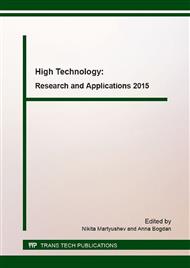[1]
G.N. Chernyshev, A.L. Popov, V.M. Kozintsev, I.I. Ponomarev, Residual stresses in deformable solids. M.: Nauka, 1996. 240 p. (In Russian).
Google Scholar
[2]
J.F. Bell, Experimental foundations of mechanics of deformable solids. In 2 parts. Part II. M.: Nauka, 1984. 432 p. (In Russian).
Google Scholar
[3]
M.V. Polonik, E.E. Rogachev, A Decrease of Residual Stresses in the Elastic-Plastic-Creep Medium at Temperature Influence, Advanced Materials Research, 1040 (2014) 870-875. DOI: 10. 4028/www. scientific. net/AMR. 1040. 870.
DOI: 10.4028/www.scientific.net/amr.1040.870
Google Scholar
[4]
M.V. Polonik, E.E. Rogachev, On the removal of residual stresses in the elastic-plastic medium for example a hollow sphere, XXXVI Far Eastern Mathematical Workshop Academician E.V. Zolotov, Vladivostok, (2012) 175-177.
Google Scholar
[5]
E.V. Murashkin, M.V. Polonik, Development of approaches to the creep process modeling under large deformations, Applied Mechanics and Materials, 249-250 (2013) 833-837. DOI: 10. 4028/www. scientific. net/AMM. 249-250. 833.
DOI: 10.4028/www.scientific.net/amm.249-250.833
Google Scholar
[6]
E.V. Murashkin, M. Polonik, Determination of a Loading Pressure in the Metal Forming by the Given Movements, Advanced Materials Research, 842 (2014) 494-499. DOI: 10. 4028/www. scientific. net/AMR. 842. 494.
DOI: 10.4028/www.scientific.net/amr.842.494
Google Scholar
[7]
A.A. Burenin, L.V. Kovtanjuk, I.A. Terletskiy, To the Formation of Residual Stress Field in the Vicinity of a Spherical Cavity Viscoelastoplastic Material, Far Eastern Mathematical Journal, 12(2) (2012) 146-159.
Google Scholar
[8]
A.A. Burenin, L.V. Kovtanyuk, M.V. Polonik, The possibility of reiterated plastic flow at the overall unloading of an elastoplastic medium, Doklady Physics, 45(12) (2000) 694-696. DOI: 10. 1134/1. 1342452.
DOI: 10.1134/1.1342452
Google Scholar
[9]
A.A. Burenin, L.V. Kovtanyuk, M.V. Polonik, The formation of a one-dimensional residual stress field in the medium of a cylindrical defect in the continuity of an elastoplastic medium, Journal of Applied Mathematics and Mechanics, 67 (2003).
DOI: 10.1016/s0021-8928(03)90014-1
Google Scholar
[10]
A.M. Lokoshchenko, Process modeling creep and stress rupture of metals. M.: MSIU. (2007).
Google Scholar
[11]
G. Carslaw, G. Jaeger Thermal conductivity of solids. Nauka: Moscow, 1964. 487 p.
Google Scholar
[12]
Physical quantities. Handbook (edited by I.S. Grigoriev, E.Z. Meylthova). M.: Energoatomizdat, 1991. (In Russian).
Google Scholar


